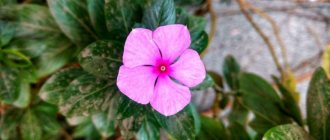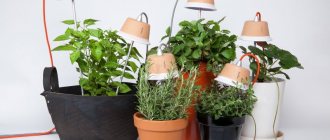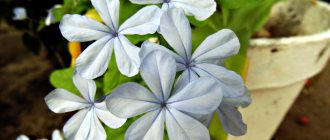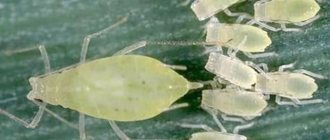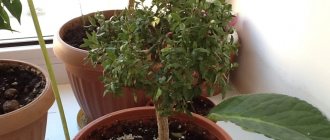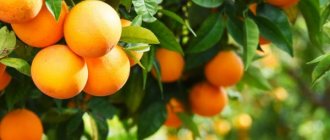Aucuba, or “golden tree,” is an exotic plant that has been attracting tourists from East Asia for many years. When the opportunity arose to export the female plant from Japan after it bore fruit, people realized that Aucuba was a dicotyledonous plant. In order for the plant to begin to spread throughout the world, a male bush was required.
It is a hardy subtropical plant that can survive even in the deep shade of a forest. There are eight species found in China, Japan, Korea and the Himalayas. An evergreen shrub with red flowers has been adapted for growing indoors. The most popular species is the Japanese aucuba.
Aucuba, with yellow spots on its leathery leaves, is a typically green shrub reaching 3-4 meters in height. During flowering, the plant displays small, inconspicuous flowers with panicles that are usually reddish or purple. The growth is lush, increasing annually by 15-20 cm in length. A potted perennial can have a lifespan of 10 years or more.
| In one season the plant reaches a height of 15-20 cm. |
| It blooms in summer and can also bloom in winter if it is very humid. |
| Blooms in spring with small red flowers. |
| Perennial. |
Beneficial features
Benefits include:
- Purifying the air from harmful bacteria;
- Treatment of burns, frostbite, bumps, bruises, bruises on the body;
- Wound care.
Absorbs the negative energy of people and is considered a tree that promotes family well-being. This flower is considered a home talisman in China, Korea and Japan, and more recently in many other countries.
What problems can arise when growing aucuba?
Among the pests that can attack a tree, the most dangerous are mealybugs. The risk of infection is especially high in the summer if you take the aucuba into the air. Pests should be gotten rid of immediately after detection, using specialized preparations.
Caring for aucuba at home requires attention to soil moisture, since a large number of problems with this tree most often arise due to excess moisture. Aucuba leaves turn black and the plant may die. In the pot in which the aucuba grows, drainage is required; the soil should not be too dense.
Features of growing at home. Briefly
Aucuba is undemanding in domestic conditions. However, this plant still requires some care:
| Temperature | The plant feels comfortable in cool conditions, the optimal temperature is 20°C, no more, and in winter from 5 to 10°C. |
| Humidity | Average. It does not suffer from dry air, but spraying will not be superfluous, especially in winter when the heating system is running. |
| Lighting | The plant needs diffused light. |
| Irrigation | Moderation in the soil is very important. Once a week in summer and once every two weeks in winter. Let the soil dry out between waterings. |
| The soil | Plants grow best in light soil. |
| Application of fertilizers and fertilizers | You can purchase organic, mineral, and granular fertilizers. Apply once every 3-4 months from spring to late summer. |
| Transfer | If the plants are young, apply the treatment once every 1-2 years in the spring. For adults, reduce the frequency to once every 2-3 years. |
| Spreading | There are 2 main methods - propagation by cuttings and propagation by seeds, but growth occurs much more slowly. |
| Special cultivation characteristics | To make it comfortable for the plant to grow and bloom indoors, in the summer you can take the pot with aucuba outside. He is able to live even in smoky air. You should also prune regularly. |
Can I keep it at home?
Aucuba has long been actively used in oriental medicine. The leaves of the plant help with:
- burns;
- frostbite;
They can also be applied to wounds and bruises to reduce pain, disinfect and speed up healing. Plant-based drugs are used to treat gastrointestinal diseases.
Remember that domestic aucuba is dangerous due to its poisonous leaves, flowers and berries. You need to make sure that children do not touch the flower.
If possible, place the pot with the plant higher where the child cannot reach. Talk to your children and explain the dangers. After working with a flower (planting, pruning), you must wash your hands thoroughly with soap. The entry of plant juice into the stomach (intestines) causes inflammation and bloody diarrhea.
Caring for aucuba at home. Details
Landing
For planting, a mixture of soil, peat and sand is used. When replanting mature plants, select and carefully follow the replanting method into another container.
Seedlings should be planted in a mixture of peat and sand or clean sand in late winter or early spring. The temperature should be maintained at 20-22 °C.
Bloom
The aesthetic appearance of aucuba is created by its large, bright green leaves. If the aucuba grows indoors, it may bloom periodically. During this period, the apical inflorescences are usually painted in red, fiery, reddish colors. The shades pair well with rich green-yellow foliage.
If both male and female specimens are present, oblong red fruits appear after flowering, somewhat reminiscent of barberry. The flowering period ends in late winter or early spring. Some people use red fruits in cooking and folk medicine.
Temperature
House aucuba will grow well at temperatures of 18-20°C in autumn and spring and 10-14°C in winter. Increasing temperatures encourage leaf shedding. In summer, the potted plant can be placed outside, but it should be protected from direct sunlight and possible precipitation.
Spraying
The aucuba flower at home requires mandatory spraying in the cold season, when the air in the house is dried by radiators and other appliances, and the central heating is turned on. If the room temperature is low, spraying should be carried out moderately and carefully, in limited quantities, otherwise it will lead to the appearance and spread of mold.
At other times of the year, you can forget about spraying the Aucuba indoor plant; this is not necessary.
Lighting
It is strictly contraindicated to place the pot near a south window. It grows even in poor light, but without light this process slows down. Varieties with dark green leaves can exist comfortably even in constant shade.
Watering
Water deeply in May and summer months. The plant should be watered when the surface of the soil begins to dry out.
During the cooler months and fall, the plant will not need additional watering. Excessive soil moisture causes the leaves to darken and worsens their appearance.
Pot
Aucuba requires special and careful care, then it can live its whole life in one pot. Therefore, it can be immediately planted in a large pot.
If you choose a medium or small pot, then over time a significant number of plant roots will interfere with its comfortable existence.
Therefore, a transplant in this case is inevitable. If you initially chose a very spacious pot, make sure it has good drainage.
Priming
To create soil, take equal proportions of turf soil, coarse sand, perlite, wet peat or humus. The pot should also have holes and drainage.
Feeding and fertilizer
Fertilize your indoor flower with watering from early spring until August. Mineral fertilizer is required in standard concentration. Follow the mixing ratio indicated by the manufacturer on the packaging. Fertilization is not required in autumn and winter, since the plant is dormant at this time of year.
With insufficient fertilizer and nutrition, small leaves appear on the stems and branches.
Transfer
Repot your aucuba plants indoors every year until they are 5 years old. Repot the plant as needed when the roots no longer fit in the pot. When the plant reaches five years of age, replanting will no longer be required.
To do this correctly, place a layer of drainage on the bottom of the pot. This will prevent excess moisture from damaging the plant. Then prepare a substrate from equal proportions of peat, leaf soil and sand. You can also prepare the soil from turf and leaf soil, mulch, sand and peat. When replanting, it is necessary to handle the Aucuba root system very carefully. They are usually very voluminous and lush.
Trimming
Pruning and pruning of young shoots should be done in March. This will give the plant a lush, straight crown. Young shoots after cutting can be used for propagation.
Rest period
The dormant period for aucuba plants begins in mid-autumn and lasts until mid-winter. From October to February, plants go dormant and many physiological processes slow down or stop completely. The flower does not produce new leaves or inflorescences.
During the hibernation period, the plant needs a temperature of 8-14°C, regular and moderate watering.
A little history
Aucuba japonica is native to subtropical East Asian forests. It is a small evergreen tree. The varieties you most often find on sale are: Hillieri, Variegata, Goldiana, Crotonifolia, Dentata.
The flower began to be found in home interiors already in the 18th century. Previously, we had only heard about it from the stories of residents of the subtropical climate zone. Residents of Japan were especially lucky, where it was widespread. They could enjoy its unusual view around the clock. But other inhabitants of the planet were allowed to contemplate the beauty of the golden bush only by visiting the vast expanses of Japan. The indigenous population carefully protected the plant, believing in its magical healing properties. Export was under the strictest ban.
It was only in the 17th century that aucuba was brought to European countries. True, there was a problem with selection. The plant was female, and a male was required for pollination. The situation changed a few decades later thanks to the scientist and botanist from England Robert Fortune. He managed to get a male flower seedling.
Transportation of decorative wood was a rather complex and costly process. Therefore, the “golden tree” decorated the houses of only the wealthiest people. Gradually, the flower began to gain increasing popularity and distribution among the inhabitants of Europe. They not only learned how to properly care for it, but were also able to significantly increase the number of copies. In the future, everyone could please themselves with the acquisition of a golden tree.
Reproduction
In plant breeding, two propagation methods are used: cuttings and seeds.
Propagation by cuttings
Propagation is propagation that uses apical shoots from the previous year. To root, shoots must have at least three leaves.
- The cuttings are placed in a mixture of peat or clean sand under plastic or glass.
- The soil should be moistened and aerated weekly, and the temperature should be maintained at 22 °C.
- Only when the cuttings are completely rooted can they be transplanted into other pots.
Growing Aucuba from Seeds
Propagation from seeds involves harvesting a fresh harvest.
- Male and female individuals growing in close proximity to each other are artificially crossed.
- The collected seeds should be sown in the ground, also covered with glass or polyethylene and placed in a warm place in the room.
- Periodically water the soil and ventilate the container.
- It will take some time before the sprouts sprout. They can be replanted into separate pots only when the young plants grow to 3-4 leaves. However, this method may lead to loss of varietal characteristics.
Poisonous or not?
Aucuba is poisonous, and the poison is contained in all its parts:
- roots;
- stem;
- leaves;
- inflorescences.
It is not safe to grow the plant where children and pets live.
Important! It is also recommended to exercise caution when transplanting and immediately wash your hands thoroughly after transplanting.
Diseases and pests
The houseplant aucuba can be affected by the following diseases:
- Aucuba leaves turn yellow and their tips wither - excess light.
- The leaves are small - this means unsaturated soil, devoid of nutrients and minerals.
- The lower leaves turn yellow early and begin to fall off - large temperature changes, irregular watering.
- Fewer yellow spots on leaves means lack of nutrients or light.
- Black spots on the leaves indicate excess moisture in the soil.
- Drying crowns - staying in a room with dry air.
- Thin shoots and slow growth are a lack of nutrition.
Indoor aucuba can be attacked by pests such as whiteflies, lepidopterans, mealybugs, and spider mites.
Photo gallery
And only after several decades it was possible to bring a male specimen to England. After its appearance, aucuba immediately became widespread. It is used as a greenhouse and indoor culture.
Types of Aucuba domestica with photos and names
There are about 8 varieties of evergreens that grow throughout the world, from the Himalayas to Japan. But two of them are considered the most popular.
Aucuba japonica
A plant with oval, smooth leaves up to 20 centimeters in size. In favorable conditions it can reach a height of up to 2 meters. During flowering, bright red panicles appear.
Fruiting is very rare. It can produce white, yellow or red berries. Regular pruning allows it to form a beautiful crown. The Japanese variety differs from other species in the location and size of the spots and is more common.
Description of the plant
Aucuba is an evergreen plant with large leathery leaves collected in a bunch. In natural conditions of existence (subtropical forests) these are ornamental trees and shrubs. In various sources it is classified as the dogwood or garriaceae family; some biologists distinguish it as the genus of aucubaceae.
The golden spots on the leaves make the flower especially attractive. Thanks to these original spots, it received its second name - golden tree. This indoor plant is quite unpretentious; growing and caring for it will not require special knowledge and will not take much time.
Folk signs
The Japanese have long noticed that aucuba has magical properties. This amazing flower helps to improve family relationships. In a house where there is a flowerpot with an evergreen tree, everyone takes care of each other, treats each other with respect and love.
Even guests who find themselves in a warm, friendly atmosphere become more cheerful and kinder. And the negativity brought from outside is immediately blocked by the sausage tree.
Be sure to get yourself a golden bush. This will bring you happiness and wealth. And if the admirer behaves indecisively, not daring to propose, give him a flowerpot with aucuba. He will immediately gain courage, you will get married, and live happily ever after.
Aucuba japonica: the original golden tree
Japanese aucuba (aucuba japonica) is the only species of the Aucuba family cultivated in home floriculture.
This is a semi-woody shrub native to Japan, the height of which can reach almost 2 m, and in open ground - up to 5 m.
The leaves of this plant are magnificent : elongated, glossy, with yellow spots scattered across them - as if golden rain had fallen on them.
This feature of the aucuba gave it another name - the golden tree. Under good conditions, the spots on the foliage become brighter and increase in size.
Aucuba japonica: useful, but poisonous
There is nothing outstanding in the flowering But the fruits - red juicy berries - look very beautiful on the bush.
As scientists have found, aucuba juice contains active substances: aucubin, aucubigenin and shikimic acid, thanks to which the plant releases volatile substances into the air that have antiviral, antifungal and antibacterial activity.
So the original shrub, originally from the land of the rising sun, can not only decorate your home, but also provide first aid for injuries, cuts, and insect bites.
Crushed leaves and fruits are used for treatment Carefully! To use Japanese aucuba as a remedy, you need to know the exact dosages and first consult with your doctor. The tissues of the plant contain toxic substances.
Popular varieties of Japanese aucuba (with photos)
In indoor floriculture, only two types of aucuba are grown: Japanese aucuba and Himalayan aucuba. Of these, gardeners like Japanese Aucuba so much that breeders have taken care of the variety of varieties of this species.
Variegata - with large leaves and golden specks scattered across them.
GoldDast – yellow color predominates on the leaves, with green inclusions.
Dentata - with jagged edges on green, pointed leaves.
Hillieri - with narrow green monochromatic leaves with sparse teeth.
Picturata - leaves with a bright yellow core and dark green edges with yellow spots.
Location and lighting
Variegated varieties of golden tree require bright, indirect light without direct sunlight. It is advisable to place them on western or eastern windows.
Aucuba with regular green leaves does not need as much light and can grow on northern windowsills.
Temperature and watering
It is advisable for the golden tree to overwinter at temperatures from 8°C to 10-12°C. If these indicators increase by just a few degrees, the plant may shed its leaves.
Watering in winter should be reduced to a minimum. Aucuba is not too moisture-loving; it will more easily tolerate the relative dryness of an earthen clod than waterlogging (because of this, black spots may appear on the foliage).
Read about caring for Tradescantia in your home garden.
If your home is favored by myrtle, take note of these simple rules for caring for it.
Know more about begonia https://sad-doma.net/houseplants/dekarativnotsvetushhie/begoniya/rodina-begonii.html and the homeland of this amazing plant.
Pruning, replanting, propagation
In March, before the start of the period of active growth, the aucuba bush needs to be “beautified.” Pinch off the tops of the shoots, trying to form a beautiful shape.
The cuttings that remain after pruning can be rooted in damp sand and then transplanted into separate containers - this is how aucuba propagates easily.
Well, to get seeds , you need to have two plants of different sexes in the house and perform artificial pollination: aucuba is a dioecious plant.
The soil for the golden tree should consist in equal parts of:
- turf land;
- leaf soil;
- peat;
- sand;
- humus.
Be careful when replanting the plant. Remember that the roots of Japanese aucuba are quite brittle.
Diseases and problems
If the basic rules of care are violated, the aucuba may acquire such signs.
- reduction of variegation due to lack of light;
- thinning of shoots due to lack of feeding;
- drying of leaf tips due to dry air and lack of watering;
- loss of brightness of leaf color in too bright light.
Aucuba is affected by: spider mites, scale insects, thrips and scale insects. If pests are found, treat the plant with an appropriate insecticide.
And a little history
For a long time, the Japanese prohibited the export of this tree from their country, protecting it almost as a national treasure. Only in the 17th century. one traveler miraculously managed to bring it to England. The aucuba took root, blossomed and bore fruit, but, of course, there were no seeds in the fruits. The tree was female.
